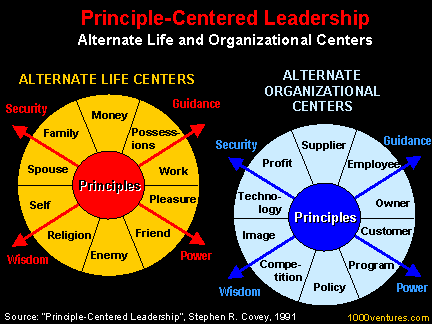
|
Principles versus
Practices |
-
Practices
– what to do's – are specific activities or actions
that work in one circumstance but not necessary in another.
-
Principles
– why to do's – have universal application; when
principles are internalized into
habits, they empower people to create a wide variety of practices
to deal with different situations.
|
|
Leading by Principles
versus Leading by Practices |
-
Leading by
Practices: all the judgment and wisdom is provided in the
form or rules and regulations; employees don't have to be the
experts and don't have to exercise judgment
-
Leading by
Principles:
requires a different type of and more training, but the payoff is more
expertise, creativity, and shared
responsibility at all levels of the organization
|
|
Principles-Centered
Leadership
Four Levels of
Practicing |
|
Principles-centered leadership is
practiced from the inside out on four levels:
-
Personal:
your
relationships with yourself
-
Interpersonal:
your
relationships
and interactions
with others
Your People Skills 360
-
Managerial: your responsibility to
get a job done with others
-
Organizational: your need to
organize people –
to recruit them, train them, compensate
them,
build teams,
solve problems, and create
aligned structure, strategy and systems
|
|
Principle-Centered Leaders
Defined
Principle-centered leaders are men and women of
character who work on the basis of natural principles and build those
principles into the center of their lives, into the center of their
relationships with others, into the center of their agreements and
contracts, into their management processes, and into their mission
statements.
Major Leadership Schools: Correlation
New Paradigm
Responding to classic dilemmas of modern
living, principle-centered leadership presents a new way of thinking that is
to help you to:
Life-Business Synergy
-
adhere to
simplicity
in the thick of increasing complexity
-
maintain a sense of direction in today's
wilderness, where well-developed road maps (strategies
and plans)
are rendered useless by rapid change that often hits you from the blind
side
-
look at human weaknesses with genuine
compassion and understanding rather than accusation and
self-justification
-
replace prejudice (the tendency to prejudge
and categorize people in order to manipulate them) with a sense of
reverence and discovery in order to promote
learning,
achievement, and excellence in people
-
get empowered (and
empower other people) with
confidence and competence to
solve problems and
seize opportunities – without being or fearing loose
cannons
Entrepreneurial Leader: 4 Specific Attributes
-
encourage the desire to change and improve
without creating more pain from the gain
-
become a contributing member of a
complementary
team
based on mutual respect and the valuing of
diversity and pluralism
-
know where to start, when and how to
recharge your batteries to maintain momentum for learning, growing and
improving.
Inspirational Leader: 10 Roles
18 Leadership Lessons from
Colin Powell
-
By treating everyone equally "nicely"
regardless of their contributions, you'll simply ensure that the only people
you'll wind up angering are the most creative and productive people in the
organization.
-
Organization charts and fancy titles count for
next to nothing. In well-run organizations, titles are also pretty
meaningless. But titles mean little in terms of real power, which is the
capacity to influence and inspire....
More
Develop a Clear Vision
The one quality that all
leaders have in common
is that they have a clear and exciting
vision for
the future. This is something that only the leader can do. Only
the leader can think about the future and plan for the future
each day.
|